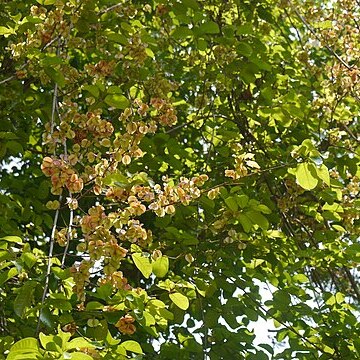Lianas large, to 30 m tall. Branchlets together with petioles usually glabrous, scaly. Leaves opposite; petiole 10-25 mm; leaf blade broadly elliptic or ovate-elliptic, 7-20 × 5-10(-13) cm, both surfaces glabrous, sparsely or not scaly, not white verruculose, base obtuse-rounded, apex obtuse or attenuate; lateral veins in 6-8 pairs, axils with small, rounded pits abaxially. Inflorescences axillary, compound, broadly cylindric, densely flowered spikes 6-10 cm, sometimes grouped at branchlet apex and forming a panicle; axes densely minutely tomentose; bracts weakly persistent at anthesis, filiform-linear, very small. Flowers very fragrant. Calyx tube in middle part funnelform or narrowly so, distally salverform, 12-15 mm, abaxially densely minutely tomentose and yellow minutely scaly, adaxially with a ring of dense, coarse hairs not or only slightly exserted; lobes 4, reflexed, deltoid to somewhat narrowly triangular, 2-3 mm, apex acuminate. Petals 4, greenish white to yellowish green or yellow, 1-1.5 mm, clawed; limb oblong-obovate, apex retuse. Stamens 8, exserted, 5-7 mm. Fruit yellowish to brownish, glossy, ± obovoid, 4-winged, 2.5-4.5 × 2.2-4 cm, sparsely minutely tomentose when young, glabrous when mature, not scaly. Fl. Jan-Apr, fr. Jun-Oct.
A vine or creeper. It can grow 30 m long. The small branches usually do not have hairs. The leaves are arranged opposite and have stalks 1-2.5 cm long. The leaves are oval and 7-20 cm long by 5-10 cm wide. The flowers are in spikes 6-10 cm long in the axils of leaves. The flowers have a scent.

